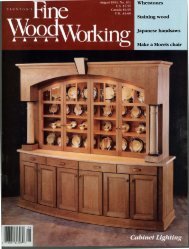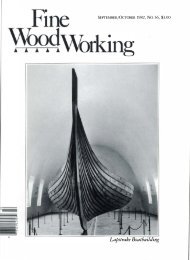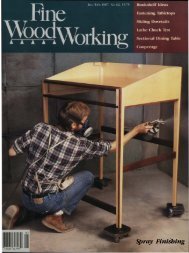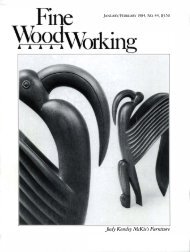NOVEMBER/DECEMBER 1983, No. 43, $3.50 Making ... - Wood Tools
NOVEMBER/DECEMBER 1983, No. 43, $3.50 Making ... - Wood Tools
NOVEMBER/DECEMBER 1983, No. 43, $3.50 Making ... - Wood Tools
You also want an ePaper? Increase the reach of your titles
YUMPU automatically turns print PDFs into web optimized ePapers that Google loves.
Cutting Dovetails With the Tablesaw<br />
A versatile way to join a stack of drawers<br />
by Mark Duginske<br />
For joining such basic casework as small boxes, chests and<br />
drawers, I've always felt that there was a missing link<br />
between the tedium of hand-cutting dozens of dovetails and<br />
the faster method of producing monotonous-looking joints<br />
with a router jig. With that in mind, I developed this tablesaw<br />
dovetail method which combines hand-tool flexibility<br />
with power-tool speed and accuracy.<br />
With this technique, you can vary both the width and the<br />
spacing of the pins and tails for praaically any aesthetic effect.<br />
The blocks that set the spacing are self-centering and will<br />
produce perfect-fitting, interchangeable joints, eliminating the<br />
need to mark boards so that individual joints will fit, as with<br />
hand-dovetailing. Besides a good combination sawblade and<br />
dado head for your tablesaw, you'll need a marking gauge, a<br />
bevel gauge and a couple of sharp bench chisels. Before proceeding,<br />
screw a wooden fence to the saw's miter gauge. A<br />
3-in. by 20-in. fence will safely support most work.<br />
Begin by squaring the ends of the boards to be joined.<br />
Take your time with this step-inaccurately prepared stock<br />
virtually guarantees sloppy results. I spaced the pins equally<br />
for the 4X-in. wide drawer parts I'm joining in the photos.<br />
You can mark the pin centers directly on the pin boards, or,<br />
as I did here, you can just cut the spacer blocks to create<br />
whatever spacing you want the pins to have. In any case, the<br />
width of the blocks should equal the distance between pin<br />
centers. You'll need one block for each full pin, plus one.<br />
The pin size is also controlled by the blocks. When they're<br />
lined up edge-to-edge, the total width of all the blocks<br />
should be less than the width of the stock by an amount<br />
equal to the width of the narrow part of each pin, that is, on<br />
the outside<br />
this<br />
face of the pin board. I chose<br />
be<br />
X-in. pins for the<br />
drawer sides shown in figure 1; if you want finer pins, decrease<br />
dimension. The blocks must of consistent width,<br />
so I crosscut them from the same ripping, then sandpaper off<br />
any fuzzy corners so that they'll line up with no gaps. To<br />
mark the depth of the pin and tail cuts, set your marking<br />
gauge to the stock thickness, and scribe a line on the faces of<br />
the pin board and on the face and edges of the tail board.<br />
Cut the tails first with the saw arbor (or table) tilted to<br />
80°, an angle that I've found produces the best combination<br />
of appearance and strength. A bevel gauge set at 80° can be<br />
used to set both the sawblade for the tails and, later, the<br />
miter gauge for the pins. As shown in figure 2, position and<br />
damp<br />
be<br />
a stop block to the miter-gauge fence so that when all<br />
the blocks are in place, a half-pin space of the correct size will<br />
CUt. At its narrowest width, the half-pin space should<br />
equal the narrow width of a pin. Raise the sawblade until it<br />
CUtS right to the gauge line, then, with all the blocks in place,<br />
begin cutting the tails, flipping the board edge-for-edge and<br />
end-for-end (photo, right). Continue this process, removing a<br />
spacer block each time, until all the tails are cut.<br />
A good-quality carbide-tipped blade will saw crisp pins<br />
50<br />
Fig. 1: Anatomy of a dovetail<br />
Half-pin<br />
Outside face<br />
Cut pins on fronts<br />
and backs of drawers,<br />
or tops and bottoms of carcases.<br />
I, j<br />
foE---<br />
Ta<br />
-4 ',4----':!-I<br />
"<br />
il 'boar�<br />
Socket<br />
In Duginske 's tablesaw dovetail method, the tails are made first<br />
in a series of cuts with the table or arbor set at 800• After each<br />
series, a spacer block is removed and the cuts are repeated for the<br />
next tail. The last tail is made with one block in place.<br />
PhO[()s: Bill Scankus; drawings: David Dann












